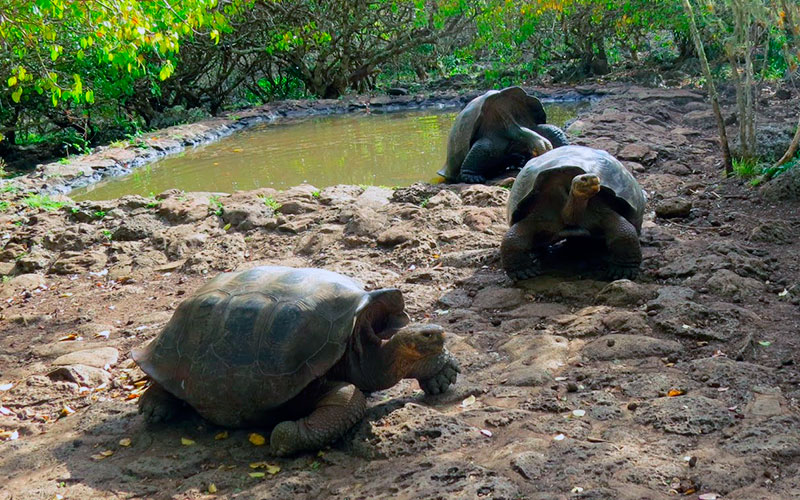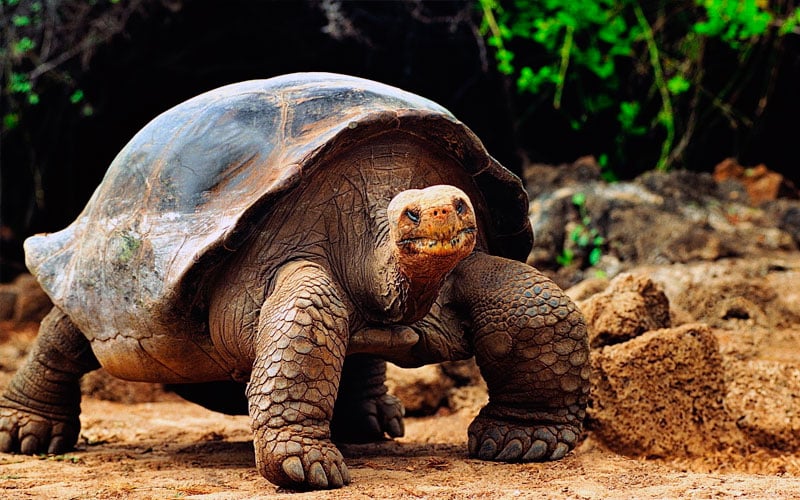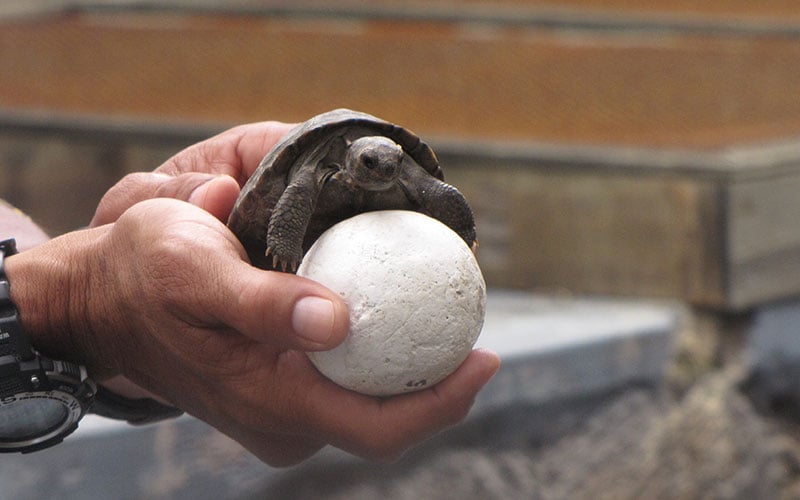After remaining for a period of 51 years in captivity at “Fausto Llerena Breeding Center”, five male tortoise returned to their natural habitat in the Island of Santa Cruz in the Ecuadorian archipelago of Galapagos. This was informed by the Galapagos National Park, in charge of the conservation and welfare of the natural habitat of the Islands.
The tortoises were returned to the hill known as “Cerro Gallina” in the western part of the island of Santa Cruz. Mr. Washington Tapia, scientific assistant for the Galapagos National Park, explained that when the Breeding Center was created in 1965, inhabitants and local institutions had the tortoises as pets, jeopardizing the existence of the specie. Now at days, and thanks to the effort of the GNP, 1200 tortoises that currently live in the Breeding Center are to be relocated in their natural habitats.
Tortoises returning to their habitat will fulfill their essential role as ecosystem engineers and contribute to the restoration of the environment. Park ranger, Freddy Villalba, in charge of the Breeding Center, mentioned that in this first group, five male tortoises belonging to the “Chelonoidis porter” species were transferred back home. Before were moved to their habitat all Scientifics registered their data and welfare, the age range of the tortoises was between 70 to 100 years old.
Two of the five tortoises will be monitored during the next 10 years to analyze their new customs, and their adaptation to the new environment, this analysis will be made through radio telemetry equipment placed inside the tortoise shell.
According to the Galapagos National Park authorities, the first hours of the integration in their new habitat was successful, as they fed and mobilized in a natural way, reactivating their wild instincts.
The Galapagos archipelago, located around one thousand kilometers from the Ecuadorian continental coasts, was declared in 1978 as a World Heritage Site by the United Nations Organization for Education, Science and Culture (UNESCO).

The Galapagos Giant Tortoise
In the middle of the Galapagos Islands coat of arms is the image of a tortoise, perfectly apt because the islands are named after the Galapagos Giant tortoise. Well actually galápago means terrapin in Spanish but the first Hispanic mariners were not splitting hairs at that time and probably intent on avoiding confusion with other islands already named Tortuga.
But you have to hand it to those first intrepid mariners; they couldn’t have found a more emblematic animal for the islands. Giant Galapagos Tortoises would have been crawling around everywhere when they arrived and were very convenient for supplies of meat. There were no cows or goats when those first mariners arrived so they set about feasting on the largest herbivores present, giant tortoises, quickly driving the reptiles to an ever more endangered state.


After an initial dispute between the Galapagos authorities and the national Ecuadorian government it was finally decided his beautifully stuffed remains would be displayed in the aptly named “Symbol of Hope Exhibition Hall in Puerto Ayora. As millions of readers and viewers took interest in his sex life in his ultimate years George probably deserves to “Rest in Peace” more than most reptiles.
With all the interest in Lonesome George you could be forgiven for thinking that Galapagos Giant Tortoises are either all in captivity or all on the cusp of extinction. Not true! The reality is a mixed bag of affairs.
There are 11 surviving species out of the original 15 species. They were already large animals when they arrived on drifting vegetation rafts 2-3 million years ago contrary to an earlier belief that they had evolved to be very large due to island gigantism, a phenomenon caused principally by lack of predators. What happened to their mainland cousins from millions of years back can only be guessed but you have to think that they were eaten by early homo-sapiens – hey, what would you rather do, go hunting for woolly mammoths or sabre-toothed tigers or upend a “delicious meat” large tortoise?
Galapagos Giant Tortoises spread to the largest ten islands and thrived until we humans put a metaphorical spoke in their wheel of existence. Buccaneers preying on Spanish treasure galleons, whalers and fur sealers found that tortoise meat was “delicious” and even better, that the giant tortoises self-preserved in a ship’s hold for up to a year – the perfect maritime provision.
From a total of hundreds of thousands of tortoises pre-human intervention there are just 20-25,000 wild tortoises living on the islands now. They are probably not about to die off in the coming years but if they are not part of a good conservancy plan then they may become endangered in the future.
In effect the Galapagos Islands are the only place where you can see giant tortoises in the wild because a distinct species living on the Aldabra Atoll in the Seychelles is shut off from human encroachment for conservancy purposes. In the Galapagos the giant tortoises live wild on Isabela, where there are 5 species each living on different volcanoes on the island, 3 species live on Santa Cruz Island, one species on Española and one species on Pinzón Island.
That there are Giant Galapagos Tortoises of the Española and Pinzón species is a miracle. Rats had virtually wiped out tortoises on Pinzón Island by the early 1960s. There were just 100-200 very old adults and all eggs laid and any hatchlings had been eaten by the rats during the course of many years. The longevity of the tortoises is what saved them as new eggs were collected and incubated and hatched back at the Charles Darwin Research Station during the late sixties. These hatchlings were reared in captivity leading the way for similar programs to be introduced for threatened giant tortoise populations on other islands.
The situation on Española was catastrophic, although it has to be noted not as catastrophic as that of poor old Lonesome George who was the last of the Pinta Island tortoises. On Española only 14 tortoises were left! There were so few they couldn’t find each other even if they did want to mate; that right there could be the definition of tragic.
Over 11 years scientists found all 14 tortoises, 2 males and 12 females, and took them away to Santa Cruz Island Tortoise Center. The males, being slightly out-numbered, were joined by Super Diego an Española tortoise in captivity in San Diego zoo. Diego earned his epitet by fathering hundreds of Española tortoises, his sex drive literally saving a race of Galapagos Giant Tortoises. Way to go Diego and well done to the females for supporting his amorous advances.

Lonely George and the Pita tortoises were not so lucky. Ditto the Floreana Island tortoises. They have gone the way of the Dodo … or have they? A recent blog post describes how new DNA advances and new field research means that it may be possible to genetically engineer these two species, scientifically raise them from the dead, so to speak.
Galapagos Giant Tortoises come in two distinct forms. Those that live or lived in the lowlands where there is less rainfall during the year and therefore a drier, thornier, less succulent foliage at ground level evolved to have longer legs, very long necks and a saddleback carapace. These tortoises were more threatened because they were easier to capture as they lived closer to the island shores. The larger dome-backed giant tortoises live in the highland interiors where due to more rainfall there is more foliage at ground level and no need for a long neck and longer limbs.
Whether you visit these giants in the highlands of Santa Cruz, in the tortoise breeding center of Puerto Ayora or on the slopes of Volcan Sierra Negra on Isabela Island you’ll be fascinated by these emblematic reptiles whose enduring story is intertwined with the history of human settlement on the Galapagos Islands and likely will continue to be so.

| Visit Darwin’s playground today, and find out more about this, and many more unique species in the Islands were evolution show its best. Contact our Galapagos Experts, and get free help on how to travel to this haven on Earth. |
New Giant Tortoise Species Found! #GalapagosIslands

Sometimes a new species is hiding in plain sight, and that is just the case of the newest species of Galapagos giant tortoise to be named. Just until recently, all the giant tortoises found on Santa Cruz Island were thought to belong to the same species Chelonoidis porteri; however, recent genetic analysis has indicated that there are in fact two distinct populations.
A research team led by Yale evolutionary biologist Adalgisa Caccone analyzed the repetitive nuclear DNA and the maternally inherited mitochondrial DNA of the two populations of giant tortoise on Santa Cruz Island and were amazed to discover that they are genetically distinct enough to be classified as separate species although they physically look very similar.
The smaller population of about 250 individuals on the eastern side of the island, the Cerro Fatal tortoises, have been described as the new, distinct species of giant tortoise and have been named Chelonoidis donfaustoi after well-known giant tortoise caretaker Fausto Llerena Sánchez. The larger population of Santa Cruz tortoises, the Reserva tortoises, inhabit the western and southwestern parts of the island.
The genetic analysis of the two species of tortoise living on Santa Cruz Island has shown that they are more closely related to tortoises on other islands than to each other despite their similar physical features. No one had previous suspected they would be so genetically different due to the close physical resemblance between the two populations.
The Galapagos Islands never cease to amaze the world. These are the islands that fascinated Charles Darwin and ultimately changed the world forever. Nature’s mysteries and secrets are still being uncovered in these enchanting islands. When you plan your holiday in the Galapagos, you are sure to discover the wonders of life in this unique equatorial paradise. Book your adventure today, and let the Galapagos Islands inspire you!
| Get in touch with one of our experts or request a callback they will be glad to assist you to find the best option to visit Española Island, the home of Diego, or to visit the Charles Darwin Research Station where other tortoises including Lonesome George are cared for! |
The Tortoise’s Re-emergence in the Galapagos
The Tortoise in the Galapagos have lived for centuries on the shores of the Galapagos Island; the oldest Giant tortoise being Lonesome George from Pinta Island. The sole member of his species, George lived to over a hundred years old without his keepers locating a mate and his lineage fell to the wayside with his death.

In March of 2015, this trend took a swing to the other side of the pendulum when new-born saddleback tortoises were found on the island of Pinzón, the first known occurrence in more than a century, according to scientists. The findings marks the re-emergence of the giant tortoise and proves that they are still able to reproduce in the wild; a question that many researchers pondered with the death of Lonesome George.
Previously, rats were at fault for the declining population of wild tortoises, attacking new hatchlings and threatening their survival. In 1970, only 19 adult tortoises were found on Pinzon, averaging 70 years old. The Charles Darwin Foundation remedied this by finding and transporting eggs to the breeding center on San Cristobal until the newborns were big enough to be reintroduced to their natural habitat.

Other efforts to help the Giant Tortoises included a pro-active push to eradicate rats on the islands, one that led to Pinzon being declared “rat free” in 2012. The invasive species is believed to have arrived on-board whaling ships in the 17th and 18th centuries, and caused a sharp decline in the tortoise population along with the whaler’s habit of using the large creatures for food.
Ten pint-sized tortoises were spotted on the islands beaches, and the team that discovered them are hopeful that others were camouflaged and out of sight.
To learn more about seeing Giant Tortoises when visiting the Galapagos, talk to one of our travel advisors today for a rundown of where to see them.
Tortoise’s Re-emergence.

Pinta Island Has Tortoises Again!
Everyone knows the sad story of Lonesome George, last of the Pinta Island Giant Galapagos Tortoises. His race was thought to be extinct until he was seen in late 1971 by some passing visitors. He was taken to the Charles Darwin Research Station, where he has remained while scientists searched on Pinta Island, in the rest of the Galapagos and in zoos around the world for a mate.
To date, no girlfriend for George has been found.
But George would be happy to know that there are tortoises once again on his old island home! This past June, 39 Giant Tortoises were released back onto Pinta Island, making them the first ones there since George was taken from his home 40 years ago.

A Need For Tortoises
The return of the tortoises isn’t simply a feel-good story about redemption. The tortoises are actually needed there. For years, Pinta was home to a thriving population of feral goats. These goats were a great nuisance and contributed to the decline of the Pinta Island Giant Tortoise in the first place. But the goats did one thing right: they controlled the plant growth on the island.
Park rangers finally managed to eradicate the goats on Pinta (and several other Galapagos Islands as well) only to find that the plants were taking over. A large herbivore was needed to restore the balance of the ecosystem. And what better choice than Galapagos Giant Tortoises?
Sterilized Hybrids
But which tortoises to choose? That question was easy for researchers. There is a large population of captive hybrid tortoises in the islands, which came from different sources. For example, longtime Floreana resident Margret Wittmer collected tortoises from different islands and kept them all together. As a result, many hybrid tortoises were hatched. Since 1976, no one has been permitted to cross-breed the tortoises, but by then there were many such hybrids (and they live a LONG time!). These tortoises are now kept on Santa Cruz and Floreana. The decision was made to sterilize these tortoises and then release them on Pinta.
Why Sterilize the Tortoises?
The reintroduction of Giant Tortoises on Pinta is a temporary solution. The goal of “Project Pinta,” as it is called, is the eventual reintroduction of Pinta Island tortoises there. Researchers have not lost hope of finding a mate for Lonesome George, and if they do, George’s offspring would be used to repopulate his former home. If they do not find a mate, then Pinta would be repopulated with Pinta Island hybrids, which would be the next best thing.
Sterilized hybrids will not reproduce in the wild, so as these 39 tortoises die off over the course of the next 150 years, they will not be replaced. Pinta Island tortoises could even be reintroduced while they’re still there!
Benefits of Project Pinta
The tortoises will form an important part of the Pinta ecosystem. They will control the vegetation and help disperse plant seeds. Certain native plant species, such as the Galapagos tomato, are particularly well suited to the tortoises, which eat the tomatoes but do not digest the seeds. These are then spread out all over the region in tortoise scat.
Scientists will study the tortoises and their behavior and adaptation in the wild, creating a sort of laboratory for re-introduction of such species. Not the least of the benefits is for the tortoises themselves: they get to live in the wild and not in a pen on Floreana somewhere!
Can we see them?
Currently, there are no visitor sites on Pinta Island, so it is impossible to see these tortoises right now. This could change in the future, however, as the park service may open up more visitor sites in the next few years.
| Don’t miss your chance and see one of the last living giant tortoises on earth, visit the Galapagos Islands and be a witness of evolution: cruises, hotels and tours |


